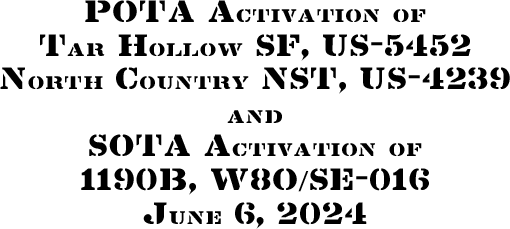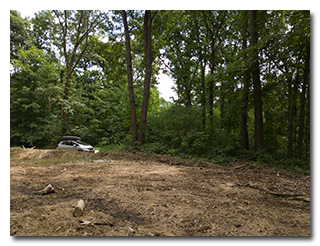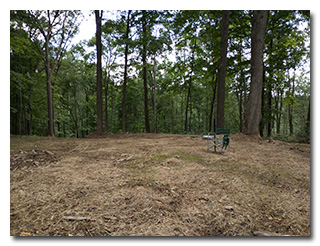
by William Eric McFadden
From the Tar Hollow State Forest's website:
-
A wealth of recreational activities is available at Tar Hollow State Forest. A 46-site primitive horse camp is located at the south end of the forest on Poe Run Road. Latrines are provided at the camp, but electricity and drinking water are not available. Radiating from the horse camp are 33 miles of bridle trails [Map]. All bridle trails are south of the fire tower.
A 22-mile network of hiking trails is located in the northern half of the forest.
Seventeen miles of paved forest roads and 14 miles of gravel forest roads provide a great opportunity for a scenic drive and allow good access to all areas of the forest.
From the North Country National Scenic Trail's website:
-
Come to the North Country. Trek the hills and valleys. Stand on the shores of lakes & streams from glaciers 10,000 years before. Clear-flowing water, red/gold of autumn, a fairyland of snow, open prairies, and distant horizons paint the land. Historic sites along the way tell how America settled and grew as a nation. From North Dakota to Vermont, adventure is never far away.
Pictures
- The view from Eric's operating location
- Eric's operating location, post-teardown
Description
On Thursday,June 6, 2024, one member of the Southeast Ohio Radio Adventure Team performed his very first Summits on the Air (SOTA) activation and successful simultaneous activations of Tar Hollow State Forest and North Country National Scenic Trail in Ohio as part of the Parks on the Air (POTA; link) program.
While driving to Portsmouth prior to two days of communications-support to the Southern Ohio Forest Rally (info) in Shawnee State Forest and Zaleski State Forest, Eric McFadden, WD8RIF, stopped at SOTA summit 1190B (W8O/SE-016), a drive-up summit located within Tar Hollow State Forest and located directly on the North Country National Scenic Trail. This was to be Eric's first-ever SOTA activation.
Having never before been there and not knowing what he would find, Eric arrived at summit 1190B at about 1745 UTC to find the summit to be a muddy, clear-cut, area. Eric was pleased that he'd not need to do any bushwacking and that the road at this point was wide enough to safely to park his car. After a few minutes of scouting to find a level space with a minimum of mud, Eric began setting up his station on his folding camp-chair a few dozen feet from his car. Eric deployed his 28½' end-fed random wire antenna as a vertical supported on a 31' Jackite telescoping fiberglass mast strapped to the folding camp-chair, laying out three 17' counterpoise wires directly on the ground. Placing his KX2 on the camp-chair's flip-up table, Eric was on the air at 1801 UTC. While Eric was setting up his station, he was visited by Will, the forest manager, who was interested to see amateur radio activity taking place within his state forest. Will explained that the summits within the state forest are often clear-cut, that area with active cutting are always well-marked, and that unmarked clear-cut areas are available for safe use.
The sky turning gray, Eric considered photographing his station before beginning his operation but unwisely chose not to. Because of this choice, he didn't manage to get a photo of his station before the rain arrived.
Eric was pleased to find he had good cell-signal and he would be able to spot himself on SOTAwatch (link) and POTA Spots (link) and to use these sites to identify possible summit-to-summit (S2S) and park-to-park (P2P) QSO opportunities.
Eric had previously announced his upcoming activations on SOTAwatch and POTA Spots so that he might be autospotted on SOTAwatch and POTA Spots.
Eric began his operation on 20m by finding a clear frequency to run and beginning to calling "CQ SOTA". He must have been quickly auto-spotted on SOTAwatch and at 1805 UTC he was chuffed that his first-ever QSO as a SOTA activator was a S2S QSO with well-known SOTA activator and hiker Steve Galchutt, WG0AT, who was performing a SOTA activation of summit 9889 (W0C/SP-111) in Colorado. As the sky darkened, QSOs came relatively quickly, with Eric's fifteenth QSO coming at 1825 UTC. Eric had also been auto-spotted on POTA Spots, and this run on 20m included a mix of S2S QSOs and QSOs with SOTA chasers and POTA hunters.
With the rain looking imminent, Eric switched to 40m and at 1830 UTC he completed a quick QSO, just as the rain really started, with his friend Thomas, K4SWL, who was performing a POTA activation of Zebulon B. Vance Birthplace State Historic Site (US-6856) in North Carolina.
20m cw 1805 WG0AT CO S2S W0C/SP-111 9889 20m cw 1807 KA0LDG ND 20m cw 1813 WW4D OK S2S W5O/OU-006 2290 20m cw 1813 AB8MR GA 20m cw 1814 WB5CTS CO 20m cw 1816 K1QT NH 20m cw 1817 W0MNA KS 20m cw 1818 KX0R CO S2S W0C/FR-039 Estes Cone 20m cw 1819 W0ERI KS 20m cw 1820 W2WC NY 20m cw 1821 K6KMH CA 20m cw 1823 K6EL CA S2S W6/NC-423 Mount Davidson 20m cw 1823 AA5UZ LA 20m cw 1824 W8TK AZ 20m cw 1825 W7DLZ CA S2S W6/NS-190 7740 40m cw 1830 K4SWL NC P2P US-6856 Zebulon B. Vance Birthplace State Historic Site
With the rain falling, Eric rushed to tear down his station while protecting his KX2 and his paper logs.
In all, Eric made sixteen QSOs, with five S2S QSOs and one P2P QSO. All of Eric's QSOs were CW and were made with five watts output.
Eric also submitted his log to the World Wide Flora and Fauna in Amateur Radio (WWFF; link) program for North Country National Scenic Trail in Ohio, KFF-5030.
(return)

